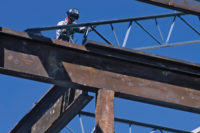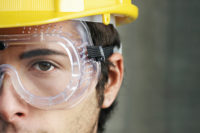OSHA fall protection regs are a baseline: ANSI standards represent current best practices.

ANSI updates
OSHA regs are mandatory, but are only baseline standards and do not necessarily represent the most current thinking. ANSI voluntary standards represent the best of today’s thinking and each of us should keep “up to speed.”
Be knowledgeable about ANSI Z359.1–2007 – “Safety requirements for personal fall arrest systems, subsystems and components,” and ANSI Z359.12–2009 – “Connecting components of fall protection systems.” (A fall arrest system is a combination of an anchorage, connectors, body harness, lanyard, deceleration device or lifeline used to arrest a fall from any working level.) A part of these standards discusses 3,600 lbs. gate strengths for both snap hooks and carabiners. This is ten times or more the strength formerly required for snap hooks.
The new ANSI Z359.1-2007, effective October 15, 2007, calls for significant increases to these critical requirements with the intent to improve overall user safety. The new standard increases the minimum gate face and side load requirements to meet or exceed 3,600 lbs. (16kN), which is more than 10 times the original standard. This standard also requires that connectors with non-integral eyes have minor axis gate strength of 3,600 lbs. (16kN). In addition to the physical testing requirements of the new standard, the gate of the connector must be marked with the load rating and the body of the connector is to be marked with a major axis load rating. Non-integral connectors are to be clearly marked with ANSI Z359.1-2007.
This may be the most significant change in fall protection standards since the ANSI requirement for full body harnesses 15 years ago. Although not mandatory, these requirements make sense, and we can’t afford to ignore them.
More best practices
The new Z359.14 Self-Retracting Lifeline (SRL) standard has now created three classes of SRLs: One that can arrest a fall in 24 inches, one in 42 inches, and one for a leading-edge application. All equipment for general industry and construction must have snap hooks and carabiners with a rated gate of 3,600 lbs. stamped on the hook gate in order to comply.
SRLs initially cost more than shock-absorbing lanyards but offer advantages. As more people begin to recognize these benefits, I believe it is as though shifting from a compliance culture to a culture of safety.
OSHA defines a “retractable” or SRL as a deceleration device containing a drum-wound line that can be slowly extracted from, or retracted onto, the drum under slight tension during normal employee movement, and which, after onset of a fall, automatically locks the drum and arrests the fall. The disc brake system, activated by any sudden movement, functions much like a seat belt. Once activated, it will stop the action of a fall.
Retractable lanyards are used when mobility is required. They may be conveniently anchored to any approved overhead anchorage. They must not interfere with ladders or vertical work areas.
Fall-arrest anchorage points must be independent of any other anchorages, such as those used to support scaffolds or suspended platforms. When evaluating an anchorage, both the direction and magnitude of applied force should be considered. They must be capable of supporting at least 5,000 pounds per employee or, alternatively, be designed and installed under the supervision of a qualified person and used as a part of a system that has a safety factor of at least two. Beam anchors offered by most manufacturers meet these criteria.
Most retractables are designed to be mounted in any position — a convenience for workers. Use of a retractable also eliminates tripping hazards. Still, workers must not become too carefree. Of concern is the “pendulum” or “swing” action of a fall.
When used properly, SRLs permits the fallen worker to most likely perform a self-rescue by climbing back to level from which he fell.
Remember the new certification for leading edge drops. The European Standard Din 360 was the first to address this issue. A complete list of the Din 360 certifications requirements follows:
Design and ergonomics
- Materials and construction
- Blocking after pre-treatment
- Blocking in a horizontal position
- Static load bearing capacity
- Static load bearing capacity for horizontal applications
- Dynamic performance
- Dynamic performance for horizontal applications
- Dynamic load bearing capacity for horizontal applications
- Optional requirement in respect to fatigue strength
- Corrosion resistance
- Identification and information
- Maximum arrest distance of 54 inches.
- Average arresting force not to exceed 900 lbs.
True story
Self-retracting lifelines (retractables) solve problems and have saved many lives, but only if used correctly. One day I received a complaint that retractables could not be mounted on the floor of a bucket truck. I visited the job site to get more information.
I learned that the buckets, although raised to maximum height, were not high enough for the job. The workers simply climbed out of the bucket and moved higher, sometimes high enough to max out the 11-foot retractables they wore. If they would have fallen, they would have experienced more than a 20-foot free fall. The lines on the retractables would have simply snapped when subjected to the force generated.
This is why training workers is so important.
Looking for a reprint of this article?
From high-res PDFs to custom plaques, order your copy today!





